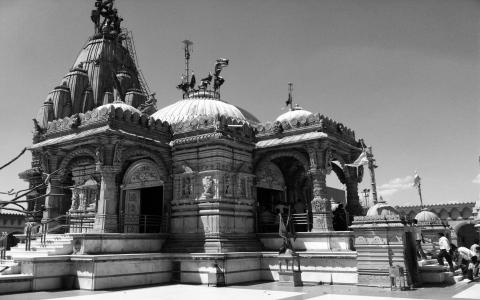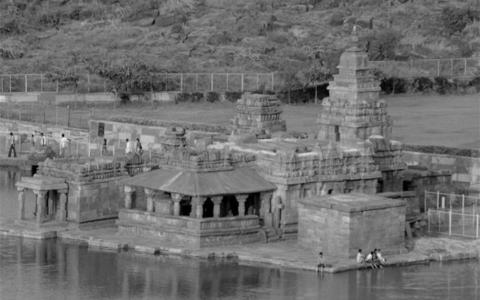July 2017

A paper titled "The Perspective of Practical Vedanta in the Works of M. Hiriyanna" was presented by Arjun Bharadwaj at the international conference "New Frontiers in Sanskrit and Indic Knowledge" (NFSI) on 12th June 2017 organized by the Chinmaya Vishwavidyapeeth. The current article contains excerpts from the paper.
Introduction: The Vedānta School of Philosophy
Indian philosophy originated under the presence of a practical need arising from...

There are many works in Sanskrit claiming Kālidāsa to be their author. However, after critical analysis, scholars are unanimous in crediting seven works to Kālidāsa. We can take a brief look at each one of them.
1. Ṛtusaṃhāram
This is a small work describing the six seasons – grīṣma (summer), varṣā (monsoon), śarat (autumn), hemanta (pre-winter), śiśira (winter), and vasanta (spring). The features of each of the seasons are described in detail...

Adhyāya 2. Parvasaṅgraha-parva
The second adhyāya contains the Parvasaṅgraha section. This contains information such as the number of parvas in theMahābhārata, the stories contained in them, the number of adhyāyas and verses in each of them. Before this, the seers ask Ugraśrava what the Samanta-pañcaka was, and in response he says, “In the period between the Tretā and the Dvāpara yugas, Paraśurāma killed a number of kṣatriyas. Five ponds filled...

India is home to a unique and vibrant civilization. It is unique for being the only ancient civilization to have survived the test of time. The ancient Egyptian, Mesopotamian, and Assyrian cultures are only of academic interest today. Even the not-so-ancient Greek civilization has been wiped out clean from its homeland. But the Vedic civilization of India, which has its origins in the Sindhu-Saraswati river basins, is very much alive today. This...

This Vyāsa-pūrṇimā, Prekshaa is delighted to present a translation of the masterly introductory essay of A R Krishna Sastri to his magnum opus, the Vacana-bhārata, which is a condensed prose rendition of the Mahābhārata in modern Kannada. The first edition of the book came out in 1950. It was hailed as a great work by his contemporaries and has remained as the authentic source of Mahābhārata in simple Kannada prose.
D V Gundappa (DVG) once...

Traditionalism
Sri Virupaksha Shastri would conduct himself like he epitomized the Shraddha or conviction in the Shastras, Karma, and virtue. Puja thrice everyday in his home. The Ekadashavara RudrAbhishekam was performed every Monday and Suryanamaskaram on Sundays. Numerous Vratas. Given this, he would mostly eat only once a day.
On one occasion during lessons, he exposited for half an hour on the sentence, “avidyAvadvishayAni shAstrANi” found...
Prekshaa Journal is run by Prekshaa Pratishtana, a non-profit trust and you can support us through donations or advertisements. If you like what you're reading and wish to contribute, get in touch!
Kindly refrain from sending us sales pitches, press releases, networking opportunities, and other promotional materials. To share your views on specific articles/essays, please use the comments section at the end of each post. At this point in time,...

Felicitation
The India Government awarded the Mahamahopadhyaya title to Sri Virupaksha Shastri. Our [Mysore] Maharaja awarded him the Vidyanidhi honorific.
And so, in order to express our joy at this, we constituted an Award Committee. B.V. Lakshman Rao (who has been mentioned earlier) was prominent in this Committee. The Award ceremony was fixed at five in the afternoon on a Sunday.
Sri Shastri’s Objection
That day at about four, a few of us...

As instructed by K Ramachandra Rao, I went to meet K A Krishnaswamy Iyer. During those days, he lived in his own house on 5th Cross, Basavanagudi (behind the house named ‘Chidvilaasa’). I went to his house at around three in the afternoon. Soon after I knocked the door, he opened it himself and ushered me inside. The room was sparsely furnished without a hint of ostentation. A bookshelf, two floor mats, a couple of cushions, and a violin – this...

This is part two of the paper presented at the international conference New Frontiers in Sanskrit and Indic Knowledge in June 2017 organized by the Chinmaya International Foundation. Part 1 of the paper can be found here.
~
Tool #1. Exposure to Arts and Culture
Just like a child is first exposed to the arts and culture in his environment, it is valuable for the learner of a language to be exposed to the cultural milieu of the language. One who...
